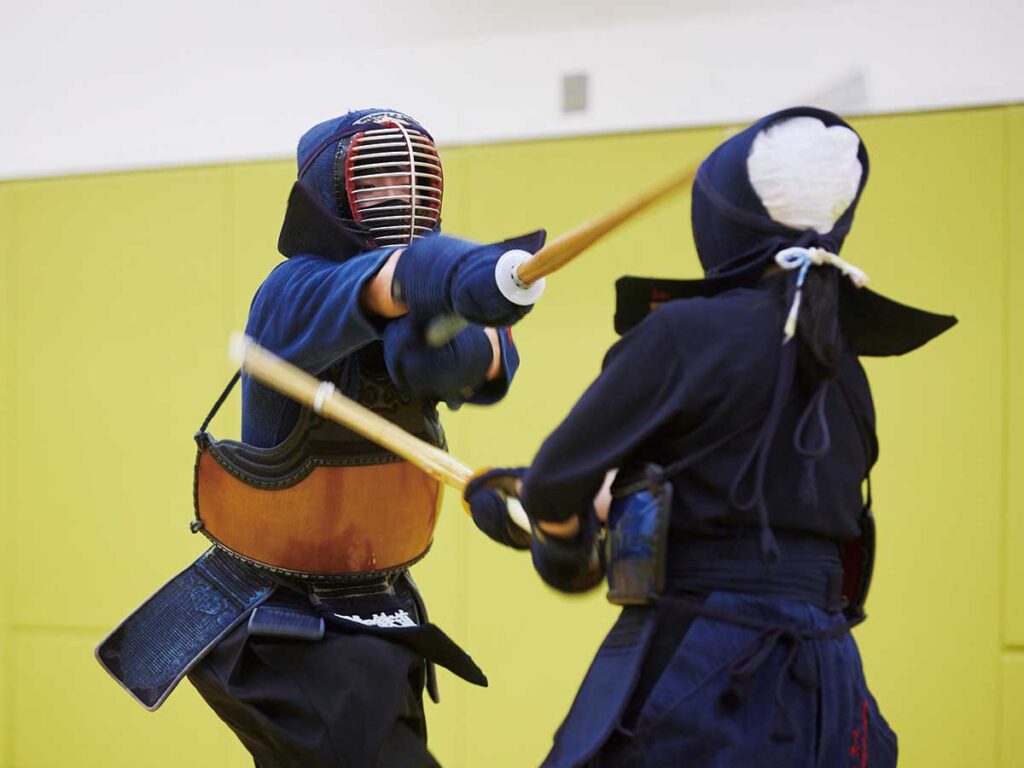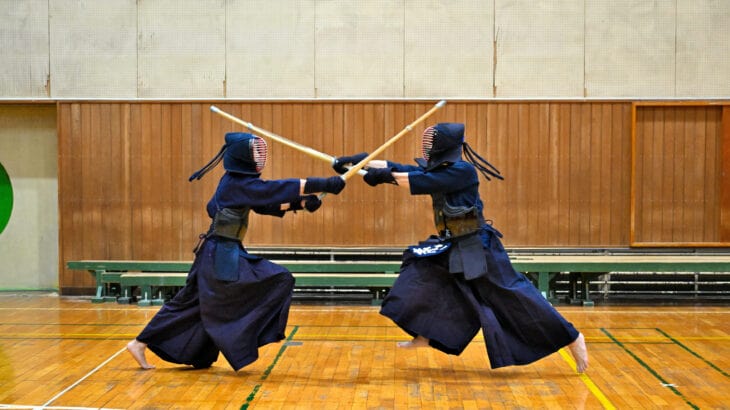
Kendo is not just a competition, but a martial art that pursues harmony between mind and body.
Among these, jumping ability is positioned as an important element that goes beyond mere physical ability.
Jumping ability is essential to Kendo techniques, such as stepping into an attack or quickly dodging an opponent’s technique.
However, many Kendo enthusiasts are looking for correct knowledge and methods on how to improve their jumping ability and utilize it in actual combat.
In this article, we will explain in detail effective training methods based on scientific evidence, from how to train jumping power in Kendo to how to use it in actual combat.
All Kendo enthusiasts, from beginners to experts, will find tips to improve their technique.
目次
- 1 The importance of improving jumping power in Kendo
- 2 Basic jumping training method
- 3 Kendo-specific jumping training
- 4 How to use jumping power in actual combat
- 5 Creating a training program
- 6 Food and nutrition to improve jumping ability in Kendo
- 7 Frequently asked questions and training misconceptions
- 8 summary
The importance of improving jumping power in Kendo
In Kendo, not only technique, but also physical strength, flexibility, and especially jumping ability are important factors.
Jumping power is the basis of various techniques in Kendo, and its improvement is directly linked to improving a Kendo practitioner’s overall performance.
Improving attack techniques
Improving your jumping power increases the speed and strength of your stepping when attacking.
In Kendo, explosive jumping power is essential to create a decisive blow, as kendo requires the technique of “one-hit-kill” technique, which allows you to take advantage of a momentary gap and strike your opponent with a deadly blow.
Strengthening defense technology
Jumping ability is also extremely important in defensive techniques. In order to quickly evade your opponent’s attacks, you need the ability to react instantly and move your body quickly.
Enhanced jumping power allows you to separate your body from opponent’s attacks, expanding your defensive options.
Improved physical strength and endurance
Training to improve jumping ability also contributes to improving the physical strength and stamina of Kendo practitioners.
Basic physical strength and endurance are required to repeatedly perform at high levels during competition, and jumping training is an effective way to improve these abilities.
mental strengthening
Improving jumping ability also increases a Kendo practitioner’s confidence and concentration.
By feeling the improvement in your own physical abilities, you will develop mental strength during matches and training, and you will be able to perform your skills in a calm and focused state.
Improving your jumping ability in Kendo not only improves your physical ability, but also contributes to improving your overall technique, physical strength, and mental strength as a Kendo practitioner.
Focusing on improving your jumping ability in your daily training can be said to be an important step in promoting your overall growth as a kendo player.

Basic jumping training method
In Kendo, basic jumping training is essential for improving performance.
Here, let’s take a closer look at squats, which build basic strength, and plyometric training methods, which build explosive strength.
Build your basic strength with squats
Squats are a basic training method for improving lower body strength.
The stepping and dodging movements in Kendo require strong muscles in the thighs and buttocks, and squats can effectively train these muscle groups.
training method
- Stand with your feet shoulder-width apart and your toes turned slightly outward.
- While keeping your back straight, bend your knees and slowly lower your hips. Be careful not to let your knees go in front of your toes.
- Lower until your thighs are parallel to the floor, then pause there for a moment.
- Return to your starting position by pressing your heels into the floor.
Aim to do this movement 10 to 15 times x 3 sets.
By gradually increasing the weight, you can improve your strength more effectively.
Build explosive power with plyometrics
Plyometrics is a training method that uses muscle extension and contraction to increase explosive force.
This type of training is effective in instantly demonstrating high jumping power in Kendo.
training method
- Box Jump : Stand in front of a 30cm-60cm box, use both feet to jump onto the box, and return to the original position as soon as you land. Do this movement 10 times x 3 sets.
- Skip jump : kick off the ground with one foot and jump as high as possible. Aim for 3 sets of 10 reps, alternating between legs.
- Burpee Jump : From a standing position, squat down, place your hands on the ground, and extend your legs behind you to get into a push-up position. Bring your feet back in front of you and jump up as fast as you can. Perform this series of movements 10 times x 3 sets.
These plyometric exercises will help you develop the explosive strength and explosive power needed in Kendo.
When training, it is important to use proper form to prevent injury.

Kendo-specific jumping training
Jumping power in Kendo is not just the ability to jump high, but also includes factors such as the speed and explosive power of the step that determine the speed and power in a match.
Here, we will explain a unique training method that strengthens stepping in Kendo and improves explosive power and jumping power at the same time.
Strengthen stepping
Strengthening the step is one of the most basic movements in Kendo, and is a necessary technique to quickly approach the opponent during an attack.
training method
- Practice stepping at a distance : Practice stepping accurately and forcefully toward a target (target or mark) in a Kendo dojo or a large space. By gradually increasing the distance from the starting position to the target and shortening the distance with each step, you will train the power and speed of your steps.
- Repeated jumps : From a position with both feet together, forcefully kick the ground and jump forward, then practice jumping again as soon as you land. This repetitive motion increases leg strength and explosive power when stepping.
Simultaneous improvement of explosive power and jumping power
Explosive strength and jumping power are important for achieving high performance in a short period of time in a Kendo match.
training method
- Shadow Strike : You actually hold a shinai and perform a striking motion in the air, but the key here is to take your feet off the ground at the moment of the strike, jump, and then transition to the next strike as soon as you land. This exercise will develop your explosive power and jumping power during attack movements.
- Power Skip : This is a training exercise that simultaneously improves the explosive power and jumping power of your legs by jumping high and moving forward with one leg at a time. Aim to jump as high and far as possible with each jump.
These kendo-specific trainings can effectively improve the speed and force of stepping, explosive power and jumping power during attacks.
By incorporating these trainings into your daily practice, you can expect to improve your performance in matches.

How to use jumping power in actual combat
Jumping power in Kendo can be effectively used in both attack and defense in actual combat.
Here, we will explain in detail how to utilize jumping techniques when attacking, and the combination of evasive movements and jumping when defending.
Jumping technique when attacking
The jumping technique when attacking provides overwhelming speed and surprise against the opponent, allowing for effective blows.
How to use it
- Jumping Step : Adds a small jump at the moment of stepping in order to shorten the reaction time to the opponent’s technique and quickly close the distance. This technique makes it easier to break through your opponent’s defenses.
- Strike in the air : By using your jumping power to strike while in the air, you can attack from unpredictable angles. This method leads to attacks that are difficult for the opponent to predict and easily break down their defense.
Combination of evasion and jumping when defending
Utilizing jumping power during defense can effectively evade the opponent’s attacks and create counter opportunities.
How to use it
- Evasion movement by jumping : Use small jumps to the side or diagonally backward to directly evade the opponent’s attack. This action allows you to dodge attacks and immediately prepare for a counterattack.
- Repositioning using jumping : Use jumping to quickly move out of range of your opponent’s attack, allowing you to counterattack from a more advantageous position. The quick repositioning by jumping makes it less predictable for opponents and provides an opportunity for effective counterattacks.
Utilizing jumping ability in actual combat gives Kendo practitioners a tremendous advantage both offensively and defensively.
This allows for unpredictable blows when attacking, and flexible and quick dodges when defending, allowing you to turn the flow of the match to your advantage.
Consciously training your jumping ability and mastering these techniques in your daily training will help you improve your skills as a kendo player.

Creating a training program
In Kendo, jumping ability is an important element not only from a technical standpoint but also from a tactical approach.
From beginners to advanced athletes, you can effectively improve your jumping ability by implementing a training program that suits your level.
Below, we will introduce jumping power improvement programs for beginners and advanced users.
Jumping power improvement program for beginners
Beginners start by building basic physical strength and strength and laying the foundation for safe training.
Program content
- Basic Squats : Do 3 sets of 10 squats 3 times a week to improve lower body strength. Once your body gets used to it, gradually increase the number of repetitions.
- Step-ups : Use a bench or low platform to perform step-ups, alternating one leg at a time. This trains the muscles you use when stepping. Perform 3 sets x 10 times 3 times a week.
- Jump roping : Incorporate 5 minutes of jump roping three times a week to improve leg strength and coordination.
Advanced jumping training for advanced users
Advanced athletes already have some basic physical strength and strength, so they develop explosive power and explosive power through more advanced training.
Program content
- Plyometrics : Incorporate plyometrics like box jumps and burpee jumps to increase explosive power. Aim to perform 3 sets x 10 times 3 times a week.
- Weighted Squat Jumps : Wearing a weighted vest or holding dumbbells, jump from a squat and squat deeply when landing to increase explosive power in your lower body. Do 3 sets x 8 reps, 3 times a week.
- Sprint training : Increase your leg strength and speed by doing short sprints repeatedly. Do 5 sets of 30m dashes, taking complete rest between each set.
Through these training programs, Kendo practitioners can aim to improve their jumping ability according to their own level.
It is important to choose a program that is suitable for you and work on it steadily while paying attention to safety.

Food and nutrition to improve jumping ability in Kendo
In Kendo, proper diet and nutritional intake are extremely important when aiming to improve jumping ability.
A well-balanced intake of nutrients that provide the energy you need for training and support muscle recovery and growth will improve your strength and endurance.
A balanced diet that supports strength and endurance
Importance of protein
Protein is an essential nutrient for muscle repair and growth. Including high-quality protein sources such as meat, fish, bean products, and dairy products in every meal will help your muscles cope with the demands of Kendo training and encourage efficient muscle growth.
The role of carbohydrates
Carbohydrates are an important source of energy, especially when consumed before and after training to help improve endurance and maintain performance during training. Focus on complex carbohydrates such as whole grains, fruits, and vegetables, and pay attention to the quality of your carbohydrates.
Appropriate intake of fat
Healthy fats are important as a source of energy during long training sessions and competitions. Eating foods rich in omega-3 fatty acids, such as fish, nuts, and olive oil, can also contribute to your overall health.
vitamins and minerals
Vitamins and minerals are necessary to support various functions in the body. In particular, calcium, magnesium, and vitamin D support bone health, and iron helps provide oxygen to muscles, so it is important to actively consume foods rich in these nutrients.
The importance of hydration
Proper hydration maximizes training efficiency and promotes muscle recovery. In particular, hydration before and after long training sessions and matches is essential for maintaining performance and preventing heat stroke.
If you are aiming to improve your jumping ability in Kendo, pay attention to these dietary and nutritional points and maintain a balanced diet to maximize the results of your training and improve your overall performance. I can.

Frequently asked questions and training misconceptions
There are a lot of questions and misconceptions about jumping strength training, and if you don’t train in the right way, you’ll not only not get results, but you’ll also increase your risk of injury.
Here we explain common misconceptions about jumping strength training and how to correct them.
Mistakes in jumping strength training and how to correct them
Myth 1: All you need to do is increase the amount of jumps
How to fix it : While increasing the quantity of your jumps is important, you should also pay attention to their quality. It is important to be conscious of high-quality jumps, including accuracy of form, jump height, and safety of landing. Also, make sure your training plan includes strength training and flexibility exercises to ensure a balanced program.
Myth 2: Heavy weight training is bad for jumping ability
Fix : If done correctly, weight training can help improve your jumping ability. In particular, squats and deadlifts, which strengthen the muscles in your lower body, are effective in building the muscle strength that is the foundation of your jumping ability. The key is to choose the right weight and train with correct form.
Myth 3: You only need to do jump training every day.
Remedies : Adequate rest is just as essential to improving your jumping ability as training. Muscles recover and grow during rest. Overtraining can lead to overtraining and injury, so it’s important to alternate training days with rest days.
Myth 4: Jumping strength training is enough for the lower body only
Modification : The core of your body (abdominal and back muscles) also plays an important role when jumping. Increased core stability allows you to jump higher and more efficiently. Therefore, it is advisable to incorporate core training into your program to improve balance and coordination throughout the body.
By understanding and practicing these common misconceptions and corrections, you can improve your jumping ability efficiently and safely.
When training, keep an eye on your body to avoid injury and improve your performance in a sustainable way.

summary
Improving your jumping ability in Kendo plays a vital role in your technical, tactical, and mental and physical growth.
In this article, we have explained training methods from the basics to advanced levels, jumping training unique to Kendo, how to use it in actual combat, and the food and nutrition that supports effective training.
We’ve also covered some common misconceptions about training and how to correct them.
When practicing Kendo, training your jumping ability is directly linked to improving your attack and defense techniques.
It provides speed and power that overwhelms the opponent when attacking, and enables quick evasive movements when defending.
These abilities are honed through daily training and proper nutrition.
The key is to strike the right balance between training quality and quantity to avoid the risk of injury from overtraining.
It’s also important to train your whole body in a well-balanced manner and don’t forget to strengthen your core.
Pay attention to your diet and nutrition to improve your jumping ability, and support your training from within your body.
Finally, avoiding misconceptions about training and practicing in the correct, scientifically based manner is the key to effective results.
In addition to improving your kendo techniques, making continuous efforts to grow both mentally and physically will pave the way to becoming a true kendo expert.





